Mahdi O. Karkush , Takwaa A. Altaher
Civil Engineering Department, University of Baghdad, Baghdad, Iraq
Correspondence to: Mahdi O. Karkush , Civil Engineering Department, University of Baghdad, Baghdad, Iraq.
| Email: |  |
Copyright © 2016 Scientific & Academic Publishing. All Rights Reserved.
This work is licensed under the Creative Commons Attribution International License (CC BY).
http://creativecommons.org/licenses/by/4.0/

Abstract
The soil contamination with oil products such as diesel fuels and heating oils are complex mixtures of hydrocarbons has been increased recently due to large development of oil industries. This study deals with the risk assessment of neighbor site to the Al-Nassyriah oil refinery in Thi-Qar city, where the byproducts of refinery plant disposed into that site. The byproduct contaminant was considered as total petroleum hydrocarbons (TPH) to avoid treating the individual minerals and compounds consisting that contaminant. The study area was divided into three parts: the first part represents the highly contaminated soil; the second part represents the slightly contaminated soil and the third part represents the intact soil which used as reference to compare the study results. Three soil samples were obtained from each part of study area to measure the variation of TPH with depth. The second part includes risks assessment due to exposure to organic contaminated soil were followed the United States environmental protection agency method (USEPA) and the risk-based corrective action method (RBCA) to evaluate the study area. The risk assessment was based on exposure assessment and toxicity assessment, which depended on data collection and experimental work. The average concentrations of TPH were 3533, 1035 and 0 ppm in the soil samples NA1, NA2 and NA3 respectively. The results of tests indicated that the three parts of site were nontoxic, but the exposure assessment of the three parts reflected that part NA1 needs for remediation when compared the concentrations of TPH with target levels.
Keywords:
Oil contamination, Petroleum hydrocarbon, Risk assessment, Site Characterization, Toxicity assessment
Cite this paper: Mahdi O. Karkush , Takwaa A. Altaher , Risk Assessment of AL-Nassyriah Oil Refinery Soil, Journal of Civil Engineering Research, Vol. 6 No. 1, 2016, pp. 16-21. doi: 10.5923/j.jce.20160601.03.
1. Introduction
Contaminated soils can represent a hazard to the health of humans, animals or plants. Thousands of sites are contaminated with both heavy metals and organic compounds and these sites cause a series problem to public health and the environment. Recently, environmental professionals have concentrated on risk-based approaches to remediate the contaminated sites. Most of the soils are polluted with oil and petroleum products at traffic accidents and because of oil spills during oil production and transportation. Petroleum hydrocarbons (PHC) are used in nearly every facet of the life. They provide energy to heat our homes and places of work, fuel our transportation systems and power manufacturing processes and tools, etc. When they are used as intended, PHCs provide great benefits to society. However, when released to the surface or inside of soil, problems can result. These include fire and explosion hazard, human and environmental toxicity, movement through soil to air or water, odor and impairment of soil processes such as water retention and nutrient cycling.Risk assessment has been internationally recognized as the most cost-effective and scientific tool for remediating the overpowering problem of the contaminated sites management [1, 2, and 3].For the assessment of environmental risks associated with soil contamination with petroleum hydrocarbons, it is important to evaluate the sources (spatial distribution and pathways) of TPH in soils. Risk assessment includes detailed site characterization, human and ecological risk quantification, and selection of remedial aims [4]. If contaminants levels after the risk assessment are unacceptable, remedial action must be selected and implemented to achieve the remedial aims in an efficient and cost effective manner. Soil being a "universal sink" bears the greatest burden of environmental pollution. Risk assessment procedures are generally based on the source-pathway-receptor model [3, 5, and 6] and encompass the examination of the site characteristics, the environmental behavior and toxicity of the contaminants, the potential route of entry of the contaminants into the receptors (humans), the exposure of the receptors to the contaminants and their response to the dose. Thus, site characterization is the basis for risk assessment. Although much scientific literature is developing on risk assessment issues [7], comparatively little attention is paid to the characterization [8].Risk assessment is a systematic evaluation of the potential risk posed by contamination to the environment components and the ecosystems under present and future conditions. The development of human health and ecological risk-based standards is a key step in the site risk assessment process. Risk-based standards are used to:a) Determine whether a remedial response action is necessary;b) Identify target cleanup levels in the event that a remedial action is required, andc) Document that a level of contamination to protect the human health and the environment been achieved at a site.
2. Effects of Total Petroleum Hydrocabons on Soil
The individual constituent of petroleum hydrocarbons affects the environment components such as soil and groundwater which degrade in accordance with their own physical-chemical properties. In soils, the petroleum hydrocarbons will absorb into the soil matrix and volatile components will gradually partition to the atmosphere. The microbial attack may causes slow degradation of the petroleum hydrocarbons. In aquatic environments, petroleum hydrocarbons will spread as a film on the surface of the water which facilitating the loss of volatile components. Most components of petroleum hydrocarbons are immiscible components, but dissolved fractions can be degrade chemically or biologically. Crude oil is not considered readily biodegradable, but the individual hydrocarbon constituents in general are regarded as inherently biodegradable. It is not practicable to evaluate every compound present in a petroleum product to assess the environmental or human health risk from disposing such components to the environment. For this reason, risk management decisions are generally based on assessing the potential impacts from a selected group of an indicator or representative compounds. Accordingly, the minor fractions of contaminant assumed to be inherent chemically. The selection of chemicals of concern is based on the consideration of exposure routes, concentrations, motilities, toxicological properties, and aesthetic characteristics [9].
3. Risk Assessment Methods
There are several methods for risk assessment of sites. The most common methods are: United States Environmental Protection Agency (USEPA) method and the risk-based corrective action (RBCA) method. More details about these methods and their applications are explained below.
3.1. USEPA Method
The method of United States Environmental Protection Agency (USEPA) is also known baseline risk assessment method, which quantifies the potential risk of contamination to human health, i.e. the ecological risk on the living organisms and wild life. The USEPA method is general and comprehensive and used to assess risk associated with any contaminated site. This method consists of four steps: (1) data collection and evaluation, (2) exposure assessment, (3) toxicity assessment, and (4) risk characterization.The data collection and evaluation includes (1) identifying the contaminants, (2) the concentrations of contaminants, (3) the sources of contamination and (4) the environmental components affected by the fate and transport of contaminants. The risk characterization combines the exposure and toxicity assessments into quantitative and qualitative expression of risk. In the case of compounds that have been classified as carcinogens, the risk base screening levels (RBSLs) are based on the Risk equation for individual carcinogens contaminant: | (1) |
Where CDI is the chronic daily intake averaged over 70 years (mg/kg-yr) and SF is the slope factor which express the exposure level for carcinogens (mg/kg-day)-1. The RBSLs values appearing correspond to probabilities of adverse health effects (“risks”) in the range from 10−6 to 10−4 resulting from the specified exposure [3]. The actual potential risk to a population for these RBSLs is lower than 10−6 to 10−4 in range [4].In the case of compounds that have not been classified as carcinogens, the Hazard Quotient (HQ) equation for individual noncarcinogens contaminant is: | (2) |
Where E is the exposure level (or chemical intake) (mg/kg-day) and RfD is the reference dose (mg/kg-day). The hazard quotients (HQ) from the specified exposure should be less than unity [9, 10]. The actual potential impact to a population based on the RBSLs levels should be lower than a hazard quotient of unity. The chronic daily intake and exposure level depend on exposure parameters such as ingestion rate, exposure duration, the source concentration, and transport rates between the source and receptor. The slope factor and reference dose are selected after reviewing a number of sources, including the USEPA Integrated Risk Information System (IRIS), database, USEPA Health Effects Assessment Summary Tables (HEAST), and peer-reviewed sources.
3.2. RBCA Method
The risk-based corrective action (RBCA) method provides a procedure for risk assessment of petroleum contaminated sites [9]. This method integrates exposure and risk assessment practices with site assessment activities and remedial measurement selection, ensuring that the chosen action is protective of human and the environment. The RBCA process utilizes a tiered approach in which corrective action activities are tailored to site-specific conditions and risks [4]. The risk assessment method consists of three tiers arises with increasing the degree of difficulty and accuracy. This tiered approach will ensure that simple cases can be completed relatively quickly with minimum efforts and cost. More data collection and tests are required to assess the risk of complex cases and potentially serious situations. Information can be gradually expanded to reduce the uncertainty and subsequently improve the rationale for making a decision. Figure 1 explains the tiered approach of RBCA method [10].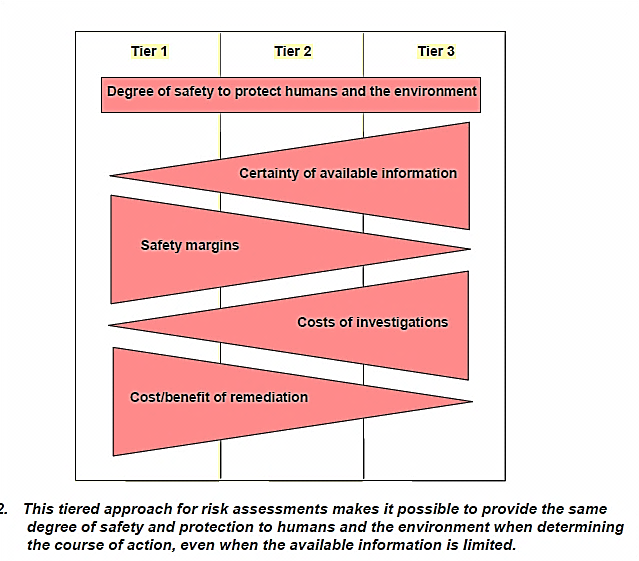 | Figure 1. Relationship among main components of tiers [10] |
Tiers approach start from one to three, the uncertainty for tier 1 is higher than that of tiers 2 and 3, but the safety margins decreased from tier 1 to tier 3 which depends on the quantity of collected information and lead to increase the cost of data collected. Thus, the cost of remediation reduced from tier 1 to tier 3 if the contaminated site required for remediation.
4. Expermental Work
4.1. Study Area
The soil samples used in this research were obtained from the open area adjacent to the Al-Nasiriya oil refinery in Thi-Qar city which is located to the south of Iraq with geo-referencing GPS coordinates (N305916.2, E0461332.8). The byproducts resulting from Al-Nasiriya oil refinery was disposed to this area which causes soil contamination. The groundwater table ranges from 2 to 2.5 m from natural ground level. The study area was divided into three locations. The three locations represent, the highly contaminated area, slightly contaminated area and intact area. The soil profile of site can be classified according to USCS as medium to stiff silty clay. The soil contamination changed the consistency of soil samples to be soft to very soft. The location of study area where the soil samples (NA1, NA2 and NA3) obtained are explained in Figure 2.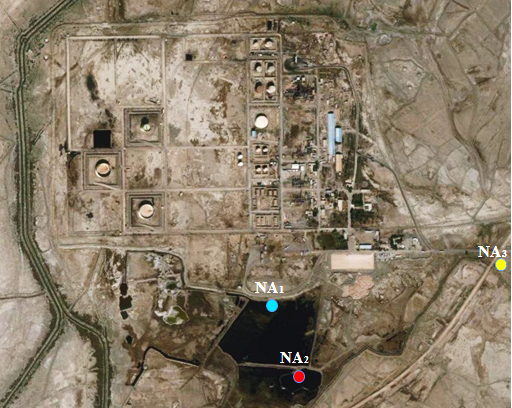 | Figure 2. Satellite image of Al-Nasiriya oil refinery |
4.2. Soil Sampling
A trial pit was excavated by using mechanical shovel to the required depths of (0.0, 1.0 and 2.0) m below the existing ground level (EGL) at each location to get the disturbed soil samples used to study the influence of contamination on the chemical properties of soil samples. The soil samples, contaminated with byproduct disposed from the refinery, were classified visually according to the color resulting from contamination. The soil samples designated as (NA1) represent the highly contaminated area, the soil samples designated as (NA2) represent the slightly contaminated area and the soil samples designated as (NA3) represent the intact area. The disturbed soil samples were putted in air-tight plastic bags and labeled then transported to the soil mechanics laboratory at the University of Baghdad. The designation and description of soil samples are listed in Table 1.Table 1. Description and designation of tested soil samples
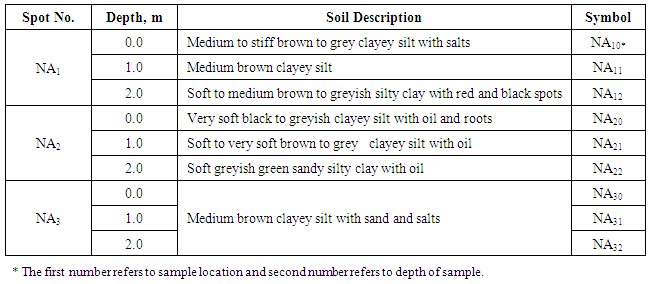 |
| |
|
4.3. Geotechnical Properties of Soil Samples
The geotechnical properties include, the chemical properties and physical properties of tested soil samples. The chemical properties of soil samples play an important role in the chemical reactions especially in case of contaminated soils. The results of chemical tests before and after remediation are given in Table 2.Table 2. Results of chemical tests
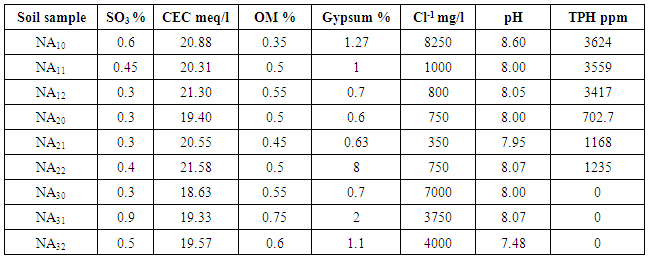 |
| |
|
The Physical properties of tested soil samples include measuring the particle-size distribution, specific gravity, Atterberg’s limits, and hydraulic conductivity. The falling head permeability test was conducted on soil samples to measure the hydraulic conductivity.
5. Results and Discussions
5.1. Physical Properties Tests
The results of physical tests are given in Figure (3) and Table 3. 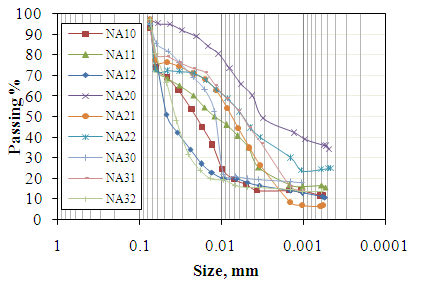 | Figure 3. Particle-size distribution curves for soil samples |
Table 3. Results of physical tests
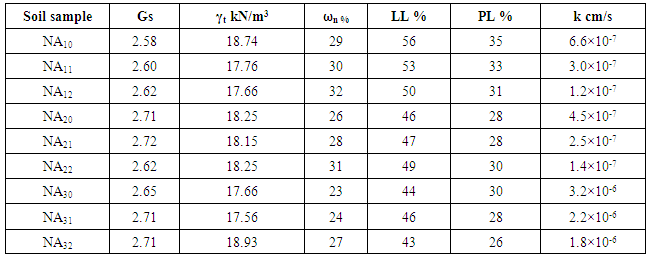 |
| |
|
The results showed that the particles of the contaminated soil samples are coarser than the intact soil samples this is due the dissolution of salts covered the fine particles in hydrometer analysis. This action depends on the solubility of existing such salts in water. Generally, increasing the concentration of TPH in soil samples causes reduction in the percentage of fines [11, 12]. The most acceptable reason for the decrease of percentage of finer may be attributed to the fact that the oil affected the physicochemical nature of the soil particularly the clayey fraction. It can be noticed that the specific gravity decreases with increasing the contaminant concentration. This action is due to the low density of the contaminant existed in the soil. The decrease in the hydraulic conductivity value of the contaminated soil in compare to that of the intact soil is attributed to clogging of some inter-particle space with crude oil and also because of the fact that pore fluid is no longer water alone but crude oil and water. There is usually a boundary layer of soil and water mixture present. TPH in soil will trap some of the water, consequently lowering the coefficient of permeability of contaminated soils.The variation of TPH with distance is shown in Figure (4) and the distribution of TPH concentration with depth is shown in Figure (5). 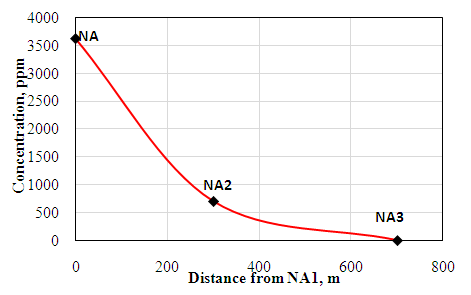 | Figure 4. Concentration of TPH with at three soil samples |
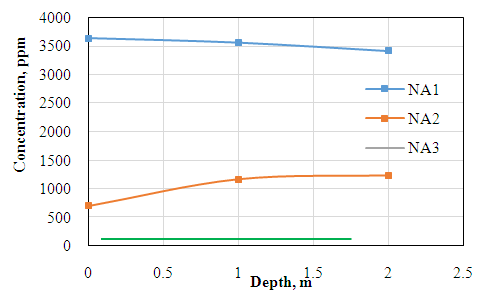 | Figure 5. Distribution of TPH with depth |
5.2. Risk Assessment of Soil Samples
In this research, the RBCA method was applied to risk assessment of the contaminated site neighbor to the Al-Nassyriah oil refinery. The site was divided visually into three parts: highly contaminated (NA1), slightly contaminated (NA2) and intact soil (NA3). Most of chemical analysis methods determine the total amount of hydrocarbons present as a single number, and give no information on the types of hydrocarbon. The total petroleum hydrocarbons (TPH) may be useful for risk assessments where the whole product toxicity approach is appropriate and to avoid the complexity in dividing the industrial wastewater disposed from the refinery into components and/or minerals and studying these components or minerals individually. Therefore the contamination of site will be evaluated according to the total petroleum hydrocarbons concentration in the soil. However, using of TPH as individual constituent in the risk assessments may be not accurate due to the lack of information about the amounts of individual compounds present in TPH. The concentration of THP obtained from the chemical analysis of soil samples were compared with target level as shown in Table 4. The adopted exposure target level of THP concentration used in this study was based on those presented by [13] as given in Table 5.Table 4. Exposure assessment of TPH in contaminated soil samples
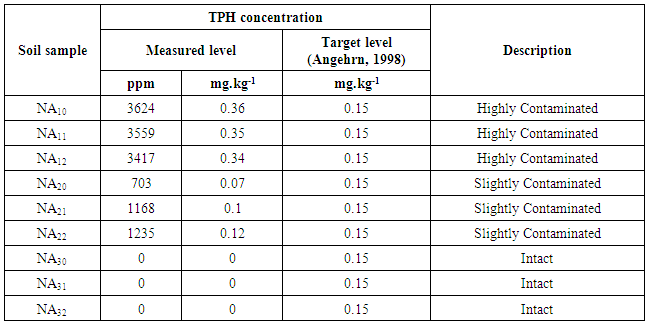 |
| |
|
Table 5. Risk based acceptable TPH concentration/emissions [11]
 |
| |
|
The results from chemical analysis of soil samples are interpreted as follows: None of the slightly contaminated soil samples (NA20, NA21 and NA22) have a contaminant level greater than the target level (acceptance level). In this instance the investigation may be terminated and the site can be utilized of in accordance with the existing or planned use and there is no significant risk to human health or the ecosystem, as a result this area does not require remediation. The land use of such site is mainly for agricultural purposes, in case of changing the land use for a more sensitive purposes require a repetition of the risk assessment to determine that the change in land use will not lead to an unacceptable exposure due to the changed acceptance criteria. The contaminant level in highly contaminated soil samples (NA10, NA11 and NA12) is greater than the target level (acceptance criteria). It must be assessed whether the results that exceed the acceptance criteria are due to the contaminant or natural background levels. This is especially relevant for inorganic substances. In order to make this assessment the local natural background levels of the contaminants must be known or determined. If the contents in one or several of the samples is not due to the background levels there are three possible ways to proceed: (1) Increase the certainty of the site specific data. Supplementary data can be procured by expanding the field investigations and a new risk analysis and the subsequent risk assessment be completed with the new information; (2) Carry out remedial measures to reduce/eliminate the risk tied to the contaminant; (3) Complete the risk assessment at the next tier. Generally the results of the risk assessment indicated that the calculated exposure level is greater than the tolerable concentration (human health and the ecosystem), or there has been observed unacceptable effects to human beings or the environment; remedial measures are required to reduce or eliminate the risk or restriction of land use will be assessed. To evaluate the toxicity assessment of study area, the calculated PRGs for n-hexane in residential soils according to the reference [14] as cited by [13] are given in Table 6. The investigated zones are considered nontoxic and the wastes are nonhazardous.Table 6. Toxicity assessment of TPH in contaminated soil samples
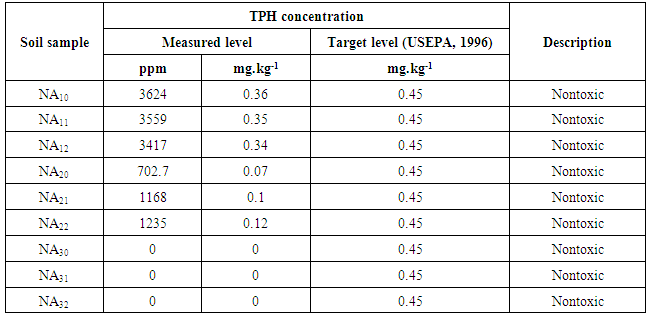 |
| |
|
The comparison of TPH concentrations in the zones of study area with target level for toxicity assessment indicated that the soil of study area is nontoxic and no remediation is required as shown in Table 6. This comparison was based on the TPH concentration in fine-gained soils used for industrial purposes. For more accurate decision, the risk assessment can be moved to tier 2 and more chemical analysis are required.
6. Conclusions
The conclusions of the study can be summarized as follows: Contamination of soil is a result of many activities done by mankind which end up contaminating the soil which increased recently due to increasing the industrial activities and urbanization. One of the wide world spread industry is the oil productions such as diesel fuels, and heating oils which are complex mixtures, mainly including of petroleum hydrocarbons covering a wide range of physicochemical properties. The risk assessment of one of the contaminated sites in Iraq is that neighbor to the Al-Nassyriah oil refinery through comparing the concentration of TPH in three zones of the study area. The risk assessment was based on exposure assessment and toxicity assessment. The target levels of TPH used in both types of assessment were obtained from the available literature published by agencies of environment protection. The results of study showed that the three zones of study area are nontoxic and for changing the land use need for more data and tests to give a more reliable decision, which means going to tier 2 of risk assessment by RBCA method. The average concentrations over depth were 3533 ppm and 1035 ppm in zones NA1 and NA2 respectively. The exposure assessment of the contaminated zones of site showed that zone NA2 not need for remediation, while zone NA1 need formation because the concentration of TPH is higher than the adopted target level.
References
| [1] | Concerted Action on Risk Assessment for Contaminated Sites in the European Union (CARACAS), 1998, Risk assessment for contaminated sites in Europe, Volume 1 Scientific basis, LQM Press Nottingham. |
| [2] | C. Ferguson and H. Kasamas (eds), 1999, Risk assessment for contaminated sites in Europe, Vol. 2. Policy Framework. LQM Press, Nottingham, pp. 1-6. |
| [3] | United States Environmental Protection Agency, 1989, Risk assessment guidance for superfund, Vol. 1. Human health evaluation manual (540/1-89/002), Washington. |
| [4] | H. D. Sharma and K. R. Reddy, 2004, Geoenvironmental engineering: site remediation, waste containment, and emerging waste management technologies, John Wiley & Sons, Hoboken, New Jersey. |
| [5] | ASTM, 1995, Standard guide for risk-based corrective action applied at petroleum release sites-RBCA, E 1739-95, West Conshohocken, PA, USA, pp. 133-145. |
| [6] | CONCAWE, 2003, European oil industry guideline for risk-based assessment of contaminated sites (revised), Report no. 3/03, CONCAWE Water Quality Management Group, Brussels. |
| [7] | C. C. Ferguson, 1996, Assessing human health risks from exposure to contaminated land: a review of recent research. Land Contamination & Reclamation, 4, pp.159-170. |
| [8] | C. Carlon, , A. Critto, A.Marcomini, ,and P. Nathanail ,2001, Risk based characterisation of contaminated industrial site using multivariate and geostatistical tools, Journal of Environmental pollution, 111, pp. 417-427. |
| [9] | ASTM, Reapproved, 2002, Standard guide for risk-based corrective action applied at petroleum release sites, E1739-95, West Conshohocken, PA. USA. |
| [10] | E. A. Vik, G. Breedveld, T.Farestveit (Grøner AS) and others, 1999, Guidelines for the risk assessment of contaminated sites, Report No. 99:06, TA-1691/1999, Norwegian Pollution Control Authority. |
| [11] | H. Al-Sanad, W. Eidand N. Ismael, 1995, Geotechnical properties of oil contaminated Kuwaiti sand. Journal of Getech. Engrg. ASCE, Vol. 121(5), pp. 407–412. |
| [12] | M. Karkush, A. Zaboon, and H. Hussien, 2013, Studying the effects of contamination on the geotechnical properties of clayey soil. Coupled Phenomena in Environmental Geotechnics, Taylor & Francis Group, London, pp. 599-607. |
| [13] | D. Angehrn, R. Gälli, J. Zeyer, 1998, Physico-chemical characterization of residual mineral oil contaminants in bio remediated soil. environmental toxicology and chemistry, 17(11), pp.2168-2175. |
| [14] | United States Environmental Protection Agency, 1996, How to effectively recover free product at leaking underground storage tank sites-guide for state regulators. EPA 510-R-96-001. |










 Abstract
Abstract Reference
Reference Full-Text PDF
Full-Text PDF Full-text HTML
Full-text HTML




